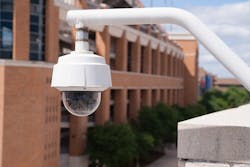Survey: More than 70 percent of U.S. adults favor cameras in schools
According to the results of a recent survey, 72 percent of U.S. adults say they are in favor of using security cameras in schools, an increase of 7 percentage points over a similar survey conducted last year. The survey, which was independently conducted on behalf of Eagle Eye Networks, polled 1,500 respondents regarding their views on cameras in schools ranging in grade level from preschool through college.
In addition to gauging overall support for cameras in schools, the “School Security Camera System Report” also examined several other areas with regards to the use of video surveillance on campuses including; the perceived positives of video surveillance; video surveillance concerns; who should be able to view video; camera location priorities; desired length of storage; and, video storage location preferences (on-site vs. cloud).
“We think that this report will help seed discussions between communities and schools in a big way about the appropriate use of security cameras in schools, which is something that is being debated in some school districts but we think it will be discussed a lot more and the information here will potentially help them,” said Dean Drako, president and CEO of Eagle Eye Networks.
An overwhelming majority of survey respondents also felt that parents should be able to view video of their children at preschool and daycare (77 percent) as well as in K-12 schools (72 percent). However, opinions varied over exactly when parents should be allowed to view video of their kids at school. Just over 50 percent of respondents said that parents should able to view video of their children anytime they want inside preschool and daycare centers, but only slightly more than 30 percent believed parents should be able to do so in K-12 facilities. Nearly 40 percent of respondents said that parents should be allowed to view video footage from K-12 schools if there is an incident involving their children while 24 percent indicated they should be able to do at preschool and daycare facilities.
“I was surprised by the number of folks who were kind of open to having parents view video all the time,” added Drako. “That number seemed a lot higher than I expected.”
There were also differences among respondents when it came to what schools should be using video surveillance for. Only 46 percent of those surveyed believed that schools should be using video to improve student behavior, while a majority, 64 percent, believed that it should be used for identifying perpetrators of criminal acts and post-incident investigation. Another 59 percent of respondents said that video should be used to provide real-time insights during emergencies and 57 percent said cameras should be used to deter crimes. Nearly 8 in 10 respondents believed it was important that first responders be granted real-time access to school surveillance cameras.
“The reason that people wanted security cameras in their schools was basically for the protection of students, staff and property,” said Drako. “There was modest enthusiasm for improving student behavior; it’s really about protection of students.”
When it comes to camera placement, the majority of those surveyed were in favor of having them installed in within the common areas of schools. Just over 75 percent of respondents were in favor of having cameras at school entrances, 62 percent were in favor of having them in hallways and 53 percent believed they should be used to watch over playgrounds, lunchrooms and gyms. Support was much less underwhelming for classrooms as only 36 percent felt cameras should be placed inside them and just 18 percent were supportive of having surveillance in locker rooms and bathrooms.
With regards to video storage, 80 percent favored storing footage for at least one month, while 40 percent believed video footage should be stored for at least one year. More than 50 percent favored using a hybrid mix of cloud and on-site storage. The advantages cited in favor of using the hybrid storage model were a reduction in possible tampering (47 percent), redundancy to prevent video loss (43 percent), extra storage capacity (43 percent), and better remote video access (36 percent).
As to be expected, budget concerns were seen as the biggest challenge facing schools that want to deploy video surveillance with 32 percent of survey respondents citing it as the top hurdle. In conjunction with the survey’s findings, however, Eagle Eye on Thursday announced the establishment of the Drako Cloud Security Grant for Schools for up to $1 million. Individual schools who are awarded the grant will receive a fully functional security camera system - including cloud management and recording, mobile phone remote access applications, cameras, networking equipment to connect IP cameras, and secure gateways to the cloud - at no cost for 1 year.
“Our goal is to make it easier for more schools to provide the highest level of safety to their students and staff,” said Drako.
Eligible schools include accredited private and public schools in the United States: elementary schools, middle schools, high schools, and colleges. Grant applications will be accepted starting March 31, 2016. Application deadline is July 1, 2016. Grant winners will be selected based on the merits and timeliness of their application. Click here for more information or to apply for the grant.



